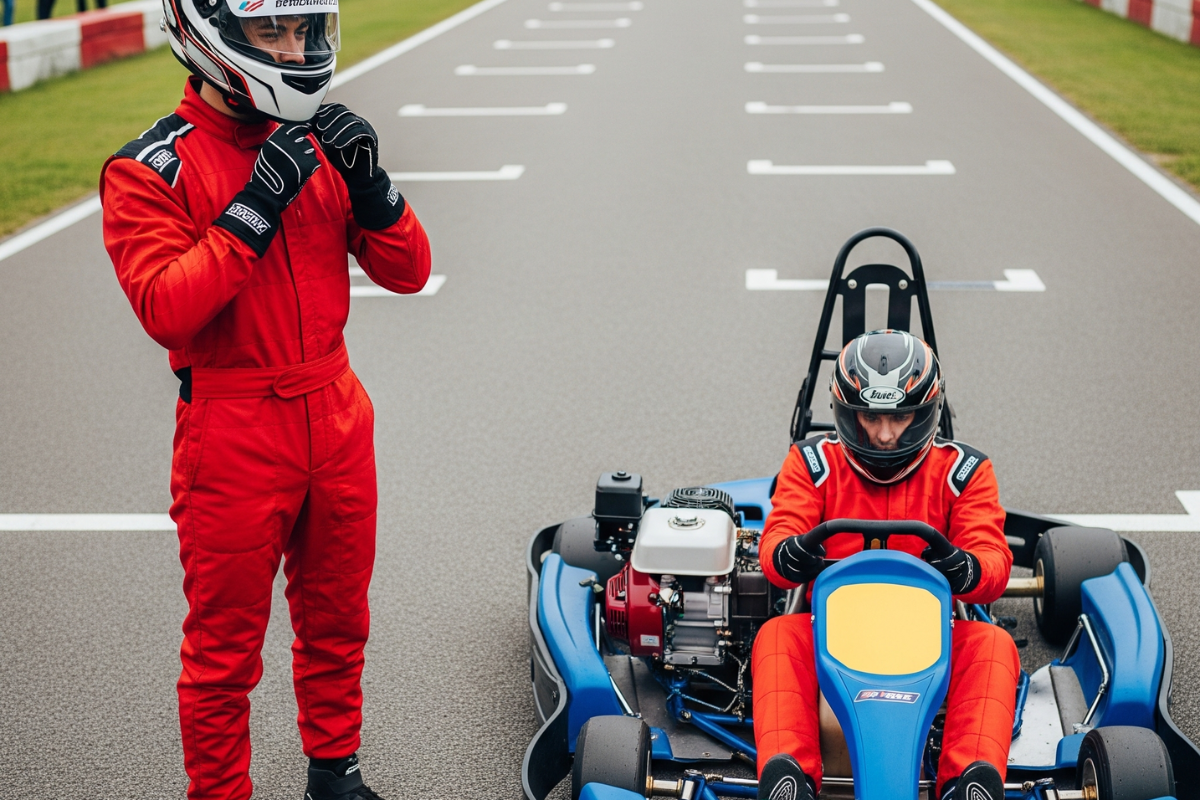Go-karting offers an exhilarating rush, a blend of speed, strategy, and pure adrenaline. Whether you’re a seasoned racer or a curious first-timer, the thrill of hugging corners and outpacing your friends is undeniable. However, beneath the excitement lies a crucial, often underestimated, element: safety. Ignoring proper safety measures in karting isn’t just risky; it’s foolish. Just as a chef needs quality ingredients, and a builder needs sturdy tools, a karter needs the right protective gear. This comprehensive guide will walk you through every piece of essential equipment, explaining why each is vital and what to look for when choosing yours. Our goal is to ensure your time on the track is not only fun but, more importantly, safe.
The Foundation of Protection: Helmets
Your head is arguably the most vulnerable part of your body during a karting session. A sudden impact, a rollover, or even flying debris can lead to severe injury if your head isn’t adequately protected. This is where a high-quality helmet becomes your first and most critical line of defense.
Why a Helmet is Non-Negotiable
A helmet’s primary function is to absorb impact energy, dispersing it across a wider area and preventing it from reaching your skull. It also protects against abrasions and punctures from track surfaces, other karts, or debris. Furthermore, a good visor shields your eyes from wind, dust, and small projectiles, maintaining clear visibility.
What to Look For: Certifications and Fit
When selecting a helmet, certifications are paramount. Look for helmets that meet or exceed safety standards set by organizations like Snell (e.g., Snell SA2020 for motorsports), FIA, or ECE. These certifications guarantee the helmet has undergone rigorous testing to ensure its protective capabilities.
Beyond certifications, fit is crucial. A helmet that’s too loose can shift during an impact, compromising its effectiveness. One that’s too tight will be uncomfortable and distracting. The helmet should feel snug around your entire head without causing painful pressure points. Your cheeks should be compressed slightly, and the helmet shouldn’t move when you shake your head from side to side or up and down. Always try on a helmet before purchasing and consider the sizing chart provided by the manufacturer. Many karters prefer full-face helmets for maximum protection, covering the entire head, face, and chin.
Protecting Your Body: Racing Suits and Rib Protectors
While a helmet safeguards your head, the rest of your body needs comprehensive protection from impacts, abrasions, and even heat. This is where a proper racing suit and rib protector come into play.
The Racing Suit: More Than Just Fabric
A karting racing suit, unlike regular clothing, is designed with specific protective features. Its robust outer shell, often made from abrasion-resistant materials like Cordura or fire-resistant aramid fibers, offers protection against road rash in the event of a slide or fall. Padded areas, strategically placed in vulnerable spots like shoulders, elbows, and knees, provide additional cushioning against impacts.
Beyond physical protection, many suits are also designed to be fire-resistant, a crucial feature in a sport involving fuel and engines. This flame retardancy adds an extra layer of safety, giving precious seconds to react in an emergency.
Key Considerations for Racing Suits
When choosing a suit, look for one that fits well – snug but not restrictive, allowing full range of motion. Pay attention to the C.I.K.-FIA homologation. This certification ensures the suit meets international safety standards for karting. Comfort is also important, especially if you’re spending extended periods on the track. Breathable materials and ventilation systems can significantly enhance your comfort during intense sessions.
The Indispensable Rib Protector
Your ribs are particularly vulnerable in a kart, especially during high-speed cornering or accidental impacts. The forces involved can cause painful bruising or even fractures. A rib protector, worn under your racing suit, is specifically designed to absorb and distribute these impacts, safeguarding your vital organs and skeletal structure. These protectors often feature rigid outer shells combined with energy-absorbing foam, molded to fit snugly around your torso. Neglecting a rib protector is a common mistake among new karters, often leading to discomfort and potential injury.
Grip and Protection for Your Extremities: Gloves and Shoes
Your hands and feet are constantly engaged in controlling the kart. They need protection from impacts, abrasions, and vibrations, as well as enhanced grip for precise control.
Racing Gloves: Beyond Basic Handwear
Karting gloves are not just about keeping your hands warm. They offer crucial protection against blisters and abrasions from the steering wheel, especially during long sessions. More importantly, they feature padded areas on the knuckles and palms to cushion against impacts and vibrations. The material used in the palm often provides enhanced grip on the steering wheel, allowing for more precise control, particularly important in fast corners. Look for gloves with external seams for comfort and pre-curved fingers to reduce fatigue.
Karting Shoes: Precision and Protection
Regular sneakers simply won’t cut it for karting. Karting shoes are designed with specific features that enhance both safety and performance. They typically have thin, sensitive soles that provide excellent pedal feel, allowing for precise throttle and brake modulation. The narrow profile of karting shoes helps prevent your feet from getting caught on the pedals or chassis.
Furthermore, karting shoes often extend up the ankle, offering support and protection against abrasions and minor impacts. Many are also designed with fire-resistant materials, adding an extra layer of safety in case of an engine fire. Look for shoes that are lightweight, breathable, and offer good ankle support.
The Often-Overlooked Lifesavers: Neck Braces and Neck Collars
While helmets protect your skull, your neck also faces significant forces during karting. Sudden accelerations, decelerations, and impacts can cause whiplash or more severe neck injuries. This is why neck braces and neck collars are becoming increasingly important pieces of safety equipment.
Neck Braces: Limiting Movement
A neck brace (or head and neck support device) is designed to limit the movement of your head relative to your torso during an impact. In the event of a collision or sudden stop, it prevents your head from whipping forward, backward, or sideways, thereby reducing the strain on your neck and spine. These devices often work in conjunction with your helmet, distributing impact forces away from your neck. While some designs are integrated into the seat, standalone neck braces offer a high level of protection and are increasingly mandated in competitive karting.
Neck Collars: Basic Support and Cushioning
A neck collar provides a more basic level of support and cushioning. It fits around your neck and helps to reduce the risk of whiplash by limiting excessive head movement. While not as comprehensive as a full neck brace, a neck collar is a good entry-level option for recreational karters, offering an added layer of safety. Both devices significantly contribute to preventing hyperextension or hyperflexion injuries to the neck.
Beyond the Basics: Understanding the Track and Your Kart
While personal protective equipment is crucial, understanding the environment you’re operating in and the machine you’re driving adds another layer of safety.
Track Rules and Etiquette: Your Guide to Safe Racing
Every karting track has its own set of rules and regulations designed to ensure the safety of all participants. These often include:
- Understanding flag signals: From the universal yellow flag (caution) to the checkered flag (race end), knowing what each flag means is vital for safe navigation and reacting appropriately to track conditions.
- Following marshal instructions: Track marshals are there for your safety. Always obey their commands without hesitation.
- Maintaining safe distances: Avoid aggressive driving and give other karters enough space to maneuver, especially in corners.
- No bumping or intentional contact: Karting is about skill, not brute force.
- Understanding the racing line: While tempting to go flat out, understanding the correct racing line helps maintain control and predictability, reducing the chances of accidents.
Pre-Race Checks: Knowing Your Machine
Before you even step into the kart, a quick pre-race check can prevent many potential issues. If you own your kart, this involves:
- Tire pressure: Correct tire pressure ensures optimal grip and handling.
- Brake functionality: Test the brakes to ensure they are responsive and effective.
- Steering responsiveness: Check for any looseness or play in the steering.
- Fuel and oil levels: Adequate levels prevent unexpected stalls or engine issues.
- Loose parts: Give the kart a quick visual inspection for any loose nuts, bolts, or components that could fail during a race.
If you’re renting a kart, the track staff usually handles these checks, but it’s always wise to do a quick visual inspection yourself and report any concerns immediately.
Investing in Your Safety: It’s Worth It
When it comes to go-karting, safety should never be an afterthought or an area where you cut corners. Investing in high-quality, properly certified safety equipment is an investment in your well-being and longevity in the sport. While renting equipment is an option at many tracks, having your own gear ensures a perfect fit, consistent protection, and better hygiene.
Remember, the fastest driver isn’t always the one who pushes the hardest; it’s often the one who drives smart, respects the machine, and prioritizes safety above all else. By equipping yourself with the right gear and understanding the essential safety protocols, you’re not just preparing for a race; you’re preparing for countless thrilling and safe experiences on the go-kart track. So gear up, stay safe, and enjoy the ride!

Ramon Splinter is a passionate go-kart enthusiast and expert who shares valuable tips and insights on Zyorb, a blog dedicated to karting enthusiasts. With years of experience on the track, he specializes in helping beginners and seasoned drivers improve their skills, optimize their karts, and master racing strategies. His articles combine technical knowledge with practical advice, making go-karting more accessible and exciting for all.

